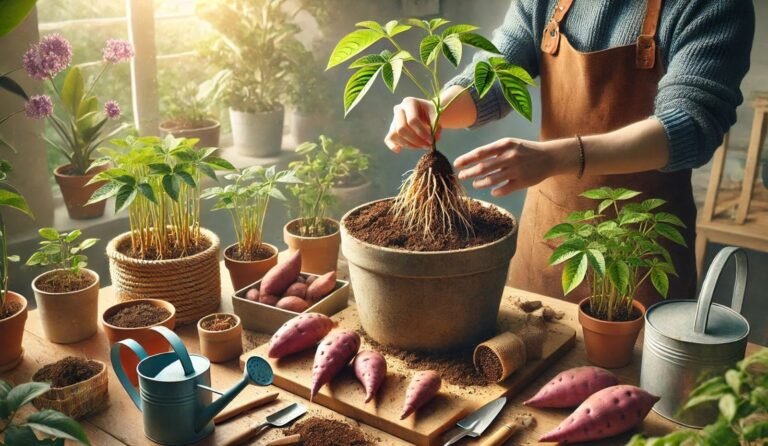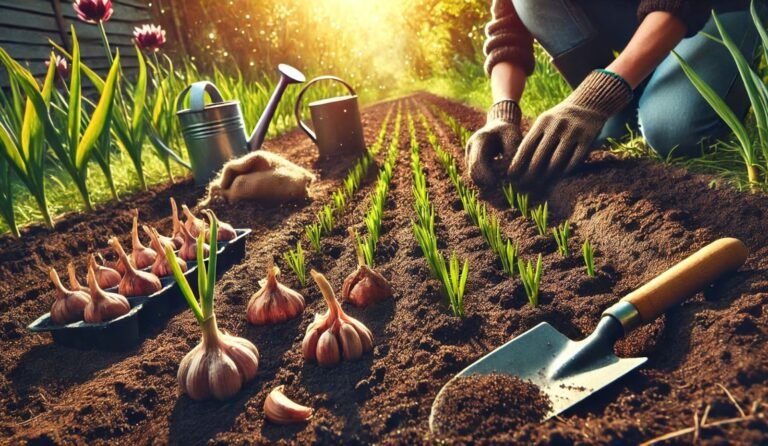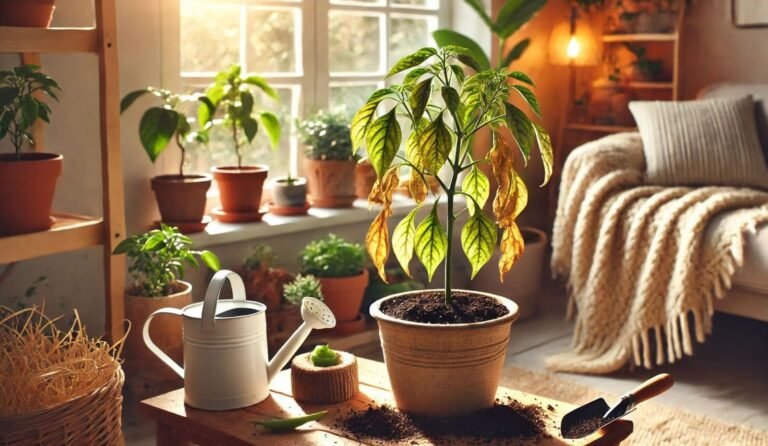Best Fertilizer for Tomato Plants: Top Picks for Healthy Growth
The best fertilizer for tomato plants is the secret to growing juicy, vibrant tomatoes that steal the show. Struggling with weak plants or small fruits? It’s not just the sun and water—your tomatoes are hungry for the right nutrients. With so many options out there, it’s easy to feel overwhelmed. Don’t worry; we’ve got you covered with the ultimate guide to picking the perfect fertilizer. Want to transform your tomato game? Let’s get started!
Why Fertilization is Crucial for Tomato Plants
Tomato plants are heavy feeders that require a balanced supply of nutrients to grow strong roots, lush foliage, and productive fruits. Without proper fertilization, you may encounter:
Blossom end rot (caused by calcium deficiency)
Yellowing leaves (due to lack of nitrogen)
Stunted growth or poor fruit production
By understanding the nutritional needs of your tomato plants, you can avoid these issues and ensure a bountiful harvest.
Key Nutrients for Tomato Plants
- Nitrogen (N): Essential for leafy growth and healthy stems.
- Phosphorus (P): Promotes root development and flower/fruit production.
- Potassium (K): Enhances overall plant health and disease resistance.
- Calcium, Magnesium, and Micronutrients: Prevents physiological disorders like blossom end rot and ensures optimal growth.
Factors to Consider When Choosing Fertilizer
Before diving into specific fertilizers, it’s essential to consider the following factors:
1. Soil Testing
Understanding your soil’s current nutrient profile is crucial. Conduct a soil test to determine deficiencies or imbalances and choose a fertilizer accordingly. For example:
- High nitrogen levels? Opt for a low-nitrogen fertilizer.
- Low phosphorus? Prioritize phosphorus-rich fertilizers.
2. Growth Stage of Tomato Plants
Tomato plants have different nutritional requirements during their life cycle:
- Seedling Stage: Focus on root development with a phosphorus-rich fertilizer.
- Vegetative Stage: Use a balanced fertilizer with higher nitrogen content to encourage leaf growth.
- Flowering and Fruiting Stage: Shift to a potassium-heavy fertilizer to boost fruit production.
3. Organic vs. Synthetic Fertilizers
- Organic Fertilizers: Derived from natural sources (e.g., compost, bone meal). They improve soil health and release nutrients slowly.
- Synthetic Fertilizers: Manufactured with precise nutrient ratios. They provide instant results but don’t enhance soil structure.
Types of Fertilizers for Tomato Plants
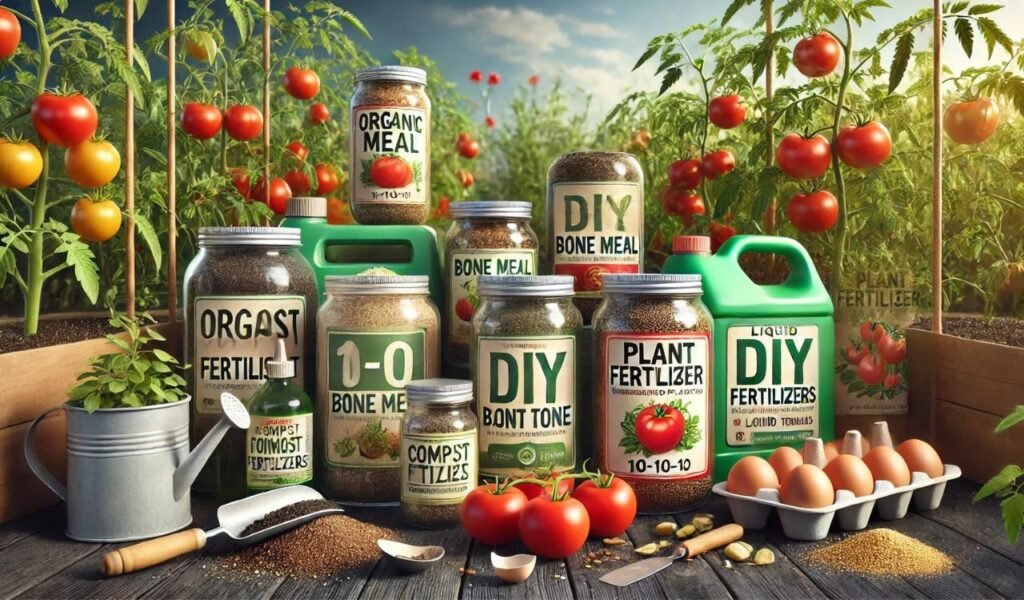
Tomato fertilizers come in various forms, each with unique benefits:
1. Balanced Fertilizers
Fertilizers labeled as 10-10-10 or 14-14-14 provide equal amounts of nitrogen, phosphorus, and potassium. Best used during the early stages of growth when the plant’s overall nutrient needs are high.
2. Organic Fertilizers for Tomato Plants
Organic fertilizers are ideal for gardeners seeking eco-friendly and sustainable options. Popular choices include:
Bone Meal for Tomato Plants: High in phosphorus and calcium, it’s excellent for root and flower development.
Compost: Provides a wide range of nutrients while improving soil structure.
Plant Tone for Tomatoes: A well-known organic fertilizer that offers a balanced nutrient profile for consistent growth.
3. Specialty Fertilizers
Liquid Fertilizers: Provide fast-acting nutrients and are ideal for correcting deficiencies during the growing season.
Slow-Release Fertilizers: Release nutrients gradually, reducing the need for frequent applications.
DIY Fertilizers: Homemade options like compost tea, banana peels, and crushed eggshells can supplement store-bought fertilizers.
Best Fertilizers for Tomato Plants: Recommendations
Here are some of the best fertilizers to consider for tomato plants:
1. Espoma Plant Tone
A popular organic option, Espoma’s Plant Tone contains a balanced mix of nutrients, including nitrogen, phosphorus, potassium, and micronutrients. It’s particularly beneficial for organic gardeners.
2. Bone Meal Fertilizer
Nutrient Profile: High in phosphorus (3-15-0)
Benefits: Supports root and flower development, prevents blossom end rot.
Application: Mix into the soil before planting or use as a side dressing during the flowering stage.
3. Dr. Earth Home Grown Tomato, Vegetable, and Herb Fertilizer
Nutrient Profile: 4-6-3 (nitrogen-phosphorus-potassium)
Benefits: Organic, non-GMO, and infused with beneficial soil microbes.
Application: Use during planting and as a top dressing.
4. Miracle-Gro Performance Organics Edibles Plant Nutrition
Nutrient Profile: 9-4-12
Benefits: Fast-acting and easy to apply as a liquid feed.
Application: Ideal for fruiting plants needing an extra potassium boost.
5. Compost and Manure
- Provides a slow-release source of nitrogen, phosphorus, and potassium.
- Improves soil structure and water retention.
- Best used as a soil amendment before planting.
Feeding Schedule for Tomato Plants
Pre-Planting Stage
Incorporate organic matter like compost or aged manure into the soil. Add a phosphorus-rich fertilizer (e.g., bone meal) to promote root development.
Vegetative Stage
Start with a balanced fertilizer (e.g., 10-10-10) every 2-3 weeks. Avoid over-fertilizing with nitrogen to prevent excessive foliage growth.
Flowering and Fruiting Stage
Transition to a potassium-rich fertilizer (e.g., 9-4-12) to encourage fruit development. Apply liquid fertilizers for quick nutrient absorption if deficiencies appear.
Organic vs. Synthetic Fertilizers for Tomato Plants
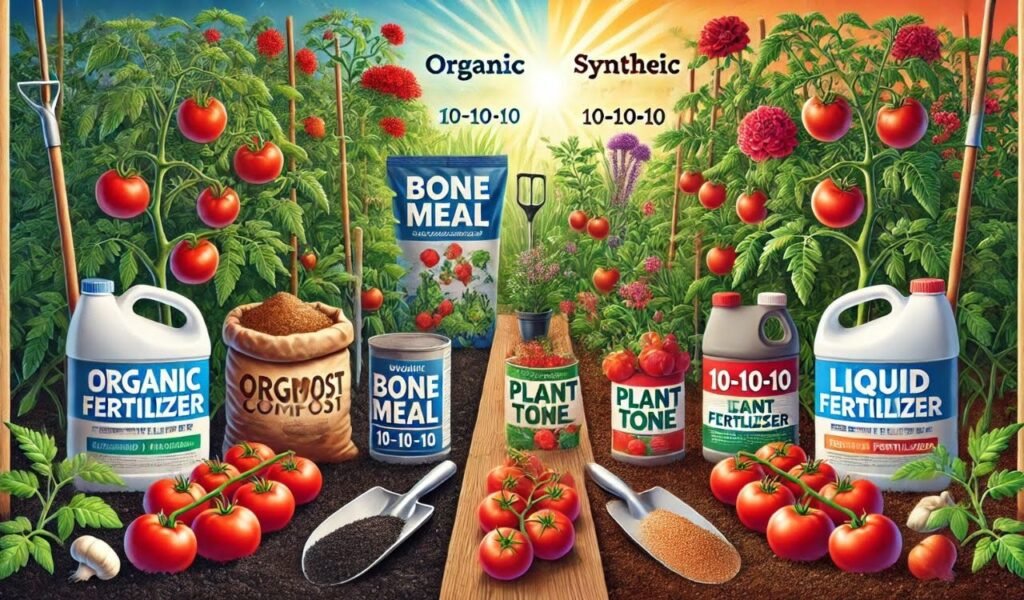
Organic Fertilizers
Advantages:
- Environmentally friendly
- Improves soil health over time
- Supports beneficial microorganisms
Disadvantages:
- Slower nutrient release
- May require larger quantities
Synthetic Fertilizers
Advantages:
- Precise nutrient ratios for targeted feeding
- Fast-acting results
Disadvantages:
- Can harm soil health with prolonged use
- Risk of over-fertilization
Additional Tips for Feeding Tomato Plants
- Use Mulch: Retains soil moisture, regulates temperature, and prevents nutrient leaching.
- Companion Planting: Grow basil, marigolds, or borage near tomatoes to enhance growth naturally.
- Regular Soil Testing: Monitor soil health and adjust fertilization practices accordingly.
- Watering Practices: Fertilizers work best when combined with consistent watering to ensure nutrients reach the roots.
Common Mistakes to Avoid
- Over-Fertilization: Too much nitrogen can lead to lush foliage but few fruits. Stick to recommended dosages.
- Ignoring Soil pH: Tomatoes prefer slightly acidic soil (pH 6.0-6.8). Use lime or sulfur to adjust pH if needed.
- Using the Wrong Fertilizer at the Wrong Time: Match fertilizer type to the plant’s growth stage.
- Uneven Application: Spread fertilizer evenly around the plant’s drip line to avoid root burn.
FAQ
What is the best fertilizer for tomato plants?
The best fertilizer for tomato plants depends on their growth stage. Early stages require a balanced fertilizer (e.g., 10-10-10) for overall growth, while flowering and fruiting stages benefit from potassium-heavy options like 9-4-12. Organic options like bone meal or Plant Tone are also great for consistent feeding.
Can I use organic fertilizers for tomato plants?
Absolutely! Organic fertilizers, such as compost, bone meal, or plant-based options, are ideal for improving soil health while providing essential nutrients. They’re sustainable and help promote long-term plant growth.
How often should I fertilize tomato plants?
Fertilization should begin at planting with a phosphorus-rich option and continue every 2-3 weeks during the growing season. Adjust frequency and type based on the plant’s growth stage and soil conditions.
What nutrients do tomato plants need the most?
Tomato plants need nitrogen for leafy growth, phosphorus for strong roots and flowers, and potassium for fruit development. Calcium is also crucial to prevent blossom end rot.
What is the difference between organic and synthetic fertilizers?
Organic fertilizers are made from natural materials like compost or bone meal and release nutrients slowly. Synthetic fertilizers are man-made, provide precise nutrient ratios, and act quickly but don’t improve soil health.
Can over-fertilizing harm tomato plants?
Yes, over-fertilizing can lead to excessive leafy growth, poor fruit production, and even root burn. Always follow recommended dosages and avoid applying too much nitrogen.
Is bone meal good for tomato plants?
Yes, bone meal is an excellent organic fertilizer rich in phosphorus and calcium, which helps in root development and prevents blossom end rot.
Can I make my own tomato fertilizer at home?
Definitely! DIY options like compost tea, crushed eggshells, banana peels, or coffee grounds can provide essential nutrients to your tomato plants naturally.
Conclusion
Finding the best fertilizer for tomato plants involves understanding your soil’s needs, the plant’s growth stages, and choosing the right type of fertilizer. Whether you opt for organic options like bone meal for tomato plants or synthetic fertilizers for quick results, the key is consistent feeding and monitoring. With proper care, you’ll enjoy a plentiful harvest of delicious, home-grown tomatoes.
Start experimenting with the recommendations in this guide, and watch your tomato plants flourish! Happy gardening!


